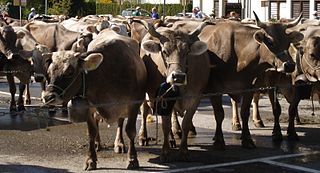
Ilex opaca, the American holly, is a species of holly, native to the eastern and south-central United States, from coastal Massachusetts south to central Florida, and west to southeastern Missouri and eastern Texas.

Helianthus or sunflower is a genus of plants comprising about 70 species. Except for three species in South America, all Helianthus species are native to North America. The common name, "sunflower", typically refers to the popular annual species Helianthus annuus, or the common sunflower, whose round flower heads in combination with the ligules look like the sun. This and other species, notably Jerusalem artichoke, are cultivated in temperate regions and some tropical regions as food crops for humans, cattle, and poultry, and as ornamental plants.
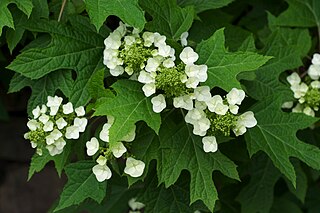
Hydrangea quercifolia, commonly known by its translation oakleaf hydrangea or oak-leaved hydrangea, is a species of flowering plant native to the Southeastern United States, in woodland habitats from North Carolina west to Tennessee, and south to Florida and Louisiana. A deciduous shrub with white showy flower heads, it is a commonly grown garden plant. Numerous cultivars are available commercially.
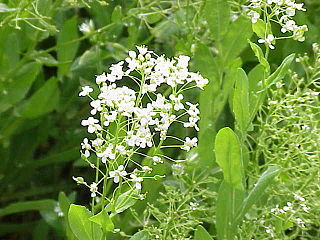
Lepidium draba, the whitetop or hoary cress, or Thanet cress is a rhizomatous perennial flowering plant in the cabbage family Brassicaceae. It is native to western Asia and southeastern Europe and widely introduced elsewhere.

Najas minor, known as brittle naiad or brittle waternymph, is an annual aquatic plant, a submersed herb. It is native to Europe, Asia and North Africa from the Netherlands to Morocco east to Japan and the Philippines, including China, Siberia, Central Asia, Iran, Turkey, Ukraine, Germany, France Italy and a host of other countries. It is now introduced to North America and considered a weedy invasive species in the eastern half of the United States from Florida to Oklahoma to New Hampshire to Ontario to South Dakota. This plant prefers calm waters, such as ponds, reservoirs, and lakes, and is capable of growing in depths up to 4 meters.

Senecio ampullaceus also known as Texas ragwort, Texas squaw-weed, Texas groundsel, and Texas butterweed is a species of Senecio in the family Asteraceae and gets its Latin name ampullaceus from its flask shaped flower-head and is a recommended native for landscape use in Texas where it came from.

Stewartia malacodendron, the silky camellia, silky stewartia or Virginia stewartia, is a species of flowering plant in the family Theaceae. It grows slowly into a large deciduous shrub or small tree, typically 3–4.5 m (10–15 ft) tall, but sometimes as tall as 9 m (30 ft). It is native to the southeastern United States.
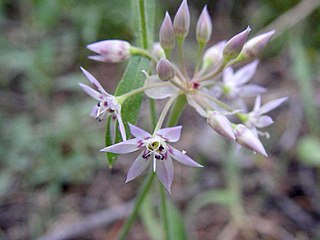
Allium campanulatum is a species of wild onion known by the common name dusky onion or Sierra onion. This is a flowering plant native to the western United States from southeastern Washington and northern Oregon to southern California, and western Nevada. The dusky onion grows in foothills and mountains, especially in dry areas, such as chaparral habitats.
Erigeron lassenianus is a species of flowering plant in the daisy family known by the common name Mount Lassen fleabane.
Allium punctum is a species of wild onion known by the common name dotted onion or Modoc onion. It is native to the western United States in and around the Modoc Plateau in northeastern California, northwestern Nevada, and southeastern Oregon. It is uncommon, growing volcanic flatlands created by old lava flows.
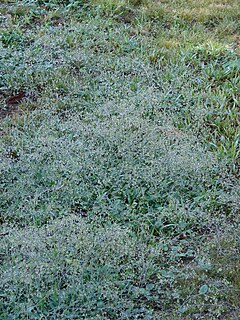
Boerhavia coccinea is a species of flowering plant in the four o'clock family which is known by many common names, including scarlet spiderling, red boerhavia, hogweed, and in Spanish, hierba del cancer and hierba de la hormiga.

Bowlesia incana is a species of flowering plant in the parsley family known by the common name hoary bowlesia. It is native to South America and the southeastern and southwestern United States as far north as Oregon. It can also be found in Pakistan and New Zealand as an introduced species. It grows in many types of habitat. This is a small annual herb growing thin, spreading stems less than 60 centimeters long. The leaves are borne on long petioles and have multilobed rounded or kidney-shaped blades less than 3 centimeters wide. The green herbage of the plant is coated in fine white hairs. The inflorescences of yellow-green flowers appear in the leaf axils. The tiny inflated fruit is only 2 millimeters wide.

Prosartes hookeri is a North American species of flowering plants in the lily family known by the common names drops of gold and Hooker's fairy bells.
Eriogonum deserticola is a species of wild buckwheat known by the common name Colorado Desert buckwheat.
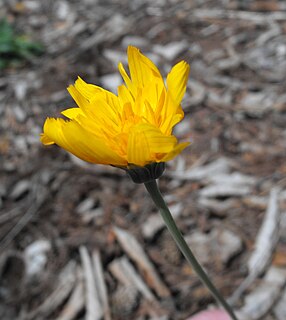
Krigia is a genus of North American flowering plants in the dandelion family. Plants of the genus are known generally as dwarf dandelions or dwarfdandelions.

Scrophularia lanceolata is a species of flowering plant in the figwort family known by the common name lanceleaf figwort. It is native to North America, where it is known from western and eastern Canada and much of the United States except for the southeastern quadrant. It grows in many types of habitat, sometimes including disturbed areas such as roadsides. It is a perennial herb producing clusters of erect or spreading stems up to 1.5 meters long. The oppositely arranged leaves have toothed, triangular or lance-shaped blades up to 14 centimetres (5.5 in) long which are borne on short petioles. The inflorescence is a wide-open panicle with several hairy, glandular branches bearing flowers. The flower has a spherical or urn-shaped corolla opening at the top into a narrow mouth edged with hoodlike lobes. The corolla is roughly 1–1.5 centimetres (0.39–0.59 in) long and is greenish tinged with brown or dull pink. The wide staminode is generally visible in the mouth of the corolla. The fruit is a capsule just under a centimeter long containing many seeds.

Amanita ravenelii, commonly known as the pinecone Lepidella, is a species of fungus in the family Amanitaceae. The fruit bodies are medium to large, with caps up to 17 cm (6.7 in) wide, and a stem up to 25 cm (9.8 in) long and 3 cm (1.2 in) thick. The warts on the whitish cap surface are large—up to 6 mm (0.24 in) wide and 4 mm (0.16 in) high. The stem has a large bulb at its base, covered with whitish to brownish scales, that may root several centimeters into the soil. The ring on the stem is thick and cotton- or felt-like. It is widely distributed in mixed and deciduous forests of the southeastern United States, where it grows solitarily or in groups on the ground in late summer and autumn. The mushrooms have a unique odor resembling bleaching powder.

Panicum hemitomon is a species of grass known by the common name maidencane. It is native to North America, where it occurs along the southeastern coastline from New Jersey to Texas. It is also present in South America.

Iris marsica is a species in the genus Iris, it is also in the subgenus of Iris. It is a rhizomatous perennial, from the Apennine Mountains, in Italy. It has glaucous, sickle-shaped or curved, light green leaves, slender stem with 2 branches, and 3 violet, light blue violet, dark violet, and dark purple flowers. It was only found and described since 1973, and is not yet in general cultivation. It was once thought to be a form of Iris germanica, but has different morphological characteristics and different chromosomal differences.
Monarda bradburiana is a species of perennial flowering plant in the mint family, Lamiaceae, that is native to much of the southeastern United States


